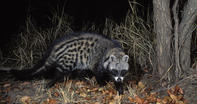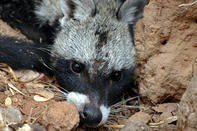
Name
Civet (civettictis civetta)Appearance
The African civet measures about 680 to 890 mm in head and body length, and has a 445 to 463 mm long tail. Its mass varies from 7 to 20 kg. Its fur is short and thick, black and white in colour with yellowish spots, bands and stripes, and the tail dense and coarse with long hair.
Its legs and most of its tail are black, the remainder of the tail having striped markings. Around the white muzzle are black markings running down its face, which is grey in colour.
Civets have long necks and black and white beams leading down their sides. Civets have 5 digits on each paw and non-retractable claws, 40 teeth and six mammae.
Civet Diet

Civets have an extremely diverse diet which is accommodated by teeth modified for both tearing and crushing. Civets eat plants and fruit, which they gather on the ground or by clambering weakly on low branches. They eat the meat of many kinds of small animals, which they catch with a pounce-bite-shake method.
They eat various kinds of poisonous food including insects, puff adders and millipedes. Civets are one of very few animals that can eat millipedes as their generalist digestive systems can deal with the cyanide found in these invertebrates.
Civets regularly raid rubbish bins and seem to process items such as plastic bags without any ill effect.
They will scavenge readily and eat the grass in the rumen of dead antelope. It may not be a co-incidence that civets, which eat poisonous and other rather unusual items, produce such noxious secretions.
presence of civets in an area is more commonly betrayed by their vast middens which are made near the paths they use to forage and are littered with millipede rings, berry kernels and seeds.
Civetries, as the middens are known, are used as territorial markers in conjunction with their scent marks and are important centres for seed dispersal. Remarkably, the dung of a civet is enormous relative to its body size and is comparable in cylindrical shape and coarse consistency to that of a baboon. By Megan Emmett
Civet Breeding
Female civets are polyestrous and can have two to three litters of one to four young per year. They are sexually mature at the age of a year. Young civets are born well developed in comparison to most carnivores. At birth, they are fully furred in a darker, shorter and softer coat than the adult civet.
Crawling after birth, their hind legs are able to support their bodies by their fifth day, showing their first signs of play behaviour at two weeks of age.
At only 17 or 18 days old, they start to leave their mother’s nest, but are entirely dependant on her milk for their first six weeks. Aged 42 days, she will start to feed them solid foods and at their second month, they will catch food themselves.
Civet Behaviour
The African civet is a solitary animal except when breeding and communicates by means of its senses of sight, smell and hearing. Civets mark their territories by wiping their perineal glands on things about 350 mm above the ground to make their presence known.
Hereby females can also communicate when they are in oestrus. Civets are somewhat docile in behaviour, and knowledge of them is limited due to their nocturnal and secretive way of life.
Civet Habitat
Civets prefer both forest and open country as their habitat and need long grass and thicket as safety during the daytime. They can be found close to permanent water sources, and make a permanent burrow to nest and bear their young.
Civets are nocturnal, terrestrial animals, yet they swim well. They are very rarely found in the dry and arid regions of Africa.
 Civets are Omnivores. Eats grass, including rumen content of dead antelopes, insects, small rodents, fruit, birds, reptiles, frogs, fish, ca...
Civets are Omnivores. Eats grass, including rumen content of dead antelopes, insects, small rodents, fruit, birds, reptiles, frogs, fish, ca... Learning about the mammals of South Africa is now so much easier for all South Africans - SouthAfrica.co.za is an excellent source of inform...
Learning about the mammals of South Africa is now so much easier for all South Africans - SouthAfrica.co.za is an excellent source of inform... Civets are stocky animals that resemble cats but are closer to dogs in size....
Civets are stocky animals that resemble cats but are closer to dogs in size....